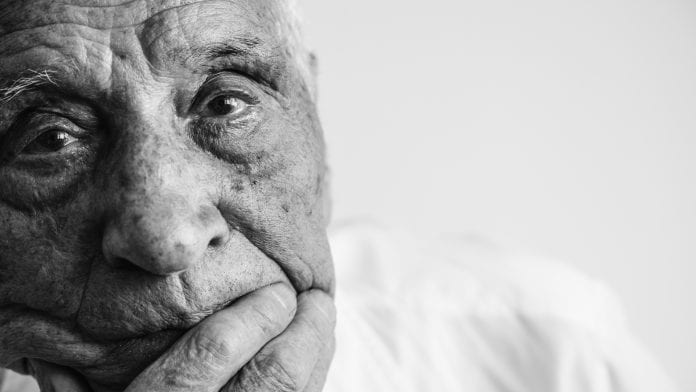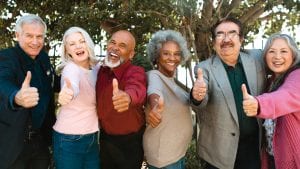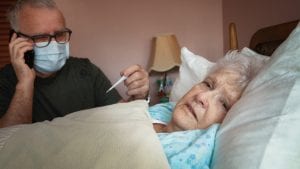
The Secretary General of the International Federation on Ageing (IFA), Dr Jane M Barratt, spoke to Health Europa Quarterly about how COVID-19 is impacting older people’s rights to access to medication.
According to the World Health Organization (WHO), COVID-19 is ‘changing older people’s daily routines, the care and support they receive, their ability to stay socially connected and how they are perceived. Older people are being challenged by requirements to spend more time at home, lack of physical contact with other family members, friends and colleagues, temporary cessation of employment and other activities; and anxiety and fear of illness and death – their own and others.’
An additional challenge facing older people is access to healthcare, whether this is in the form of medications or medical appointments. There is also concern that the older population may face challenges in accessing important current vaccinations such as that for flu, as well as the COVID-19 vaccine, when it becomes available.
The International Federation on Ageing (IFA) is an international non-governmental organisation with a membership base comprising government, NGOs, academics, industry, and individuals in 75 countries. Its goal is to be the global point of connection and networks of experts and expertise to influence and shape age-related policy.
Health Europa Quarterly spoke with the IFA’s Secretary General, Dr Jane M Barratt, about some of the main issues facing the older generation during the COVID-19 pandemic, as well as what needs to change.
In April 2020, the WHO advised that over 95% of COVID-19 fatalities worldwide were among adults over the age of 60. What are your thoughts on how this disproportionate impact has been handled by different countries?
First of all, COVID-19 has brutally exposed what we already know: that older people are not valued. We knew that before, but the coronavirus has highlighted the position in which older people are placed within communities. This is at the global level, and there is no country that has handled how COVID-19 has affected the older population very well.
There have also been confusing messages in many countries. On the one hand, governments were acknowledging the need to do more for seniors; and on the other, they have said that limited funding and equipment has meant they have had to choose who will receive the necessary care. The early benchmark here was age, with a disregard for existing health conditions within the senior population which could place these individuals at a heightened risk. Thus, we have seen a paradoxical approach to how older people have been seen during the pandemic: sometimes as a value to society, and sometimes as a burden.
It is also extremely important to understand that older people are not all the same: some are healthy and live at home, sometimes into their 90s or even hundreds; and then there are those who have high dependency conditions and reside in long-term care facilities. However, the approach taken towards older people by many governments has been to place both these groups into the same category – which is wrong. Moreover, we have seen alarmingly high coronavirus fatalities in many care home settings around the world, which demonstrates just how badly many countries have done in terms of protecting older citizens. This fatality rate is due in large part to an insufficient understanding of infection prevention and control measures by many healthcare workers in residential care facilities, as well as a lack of PPE, which has then placed older people at an enhanced level of risk. In addition to this, visits from residents’ family members who have been anxious to see their older family members have also served to spread the infection.
Some parts of Australia, however, have handled this very well by implementing a complete lockdown very early on in the pandemic. While that, of course, caused great anxiety for families who had loved ones in long-term care facilities, it saved lives.
For those living in the community, things have been a little different. Here, many older people have been isolating for their own protection; and there has been a marked increase in mental health issues such as loneliness and anxiety as a direct result of this. Furthermore, older people in isolation have also been unable to attend medical appointments for routine measures.
There have been high fatality rates, but we don’t currently know the extent of the impact of COVID-19 on the longer-term functionality of survivors. There have been some very worrying reports from healthy people who have survived the disease – for instance, after 66 days of COVID, some have hardly been able to get out of a chair and have a shower. If this is the effect on healthy people, then I am very concerned about the potential effects that will be experienced by older COVID-19 patients and survivors because the functional ability of a person is crucial when it comes to deciding whether they are going to be able to look after themselves in the community, or whether they will need to enter into a residential care facility.

How have WHO documents such as ‘Strengthening Preparedness for COVID-19 in Cities and Urban Settings’ helped to tackle the effects of the pandemic in different settings and environments?
When considering the delay in formalising such guidelines it is important to recognise that they are evidence-based, and that gathering the data takes time. It is also important to understand that they are meant to be contextualised in a specific setting; so when guidelines are published on long-term care and COVID-19, then whoever is implementing them needs to analyse their own system before they can understand how the guidelines can be applied.
The WHO has been criticised by some for developing guidelines that apparently don’t fit, and that is because this contextualisation is not being taken into account; it is up to the Member States to adapt and apply the guidelines to their own national setting. This is crucial when it is understood that, for instance, the funding that is available for vaccinations differs from country to country.
Similarly, in the field of ageing we need to explore how such guidelines are being applied, because in some instances minor changes may need to be made. For example, the definition of long-term care can differ between countries, so we need to define the terms and so understand what the guidelines mean, before we can adapt and then apply them. There are numerous settings: when we look at rural versus urban settings, as in the guidelines you have mentioned, in 2018 some 831 million people lived in urban regions in China, while 564 million people lived in rural regions in the same country. As such, we need to look at the environment in which these guidelines are landing.
An additional issue stems from the fact that many people, myself included, live in a very entitled world which has seen urban development and where we live in houses and apartments with all the necessary amenities and so on. Meanwhile, there are many people in countries such as India, for instance, who live together in tiny (by Western standards) accommodation in locations with none of the things that we take for granted in the West, such as running water, and without access to things like soap – both of which are integral to the prevention and control of the coronavirus. It is therefore crucial that we look at how such guidelines can also be applied to those settings in a way that is meaningful to that population. Otherwise, they will simply be missed.
Finally, there are many multicultural societies in the western parts of the world. For instance, in downtown Toronto alone there are 200 languages spoken amongst a population of 6.2 million. This highlights the need once more for countries to ensure that the guidelines are adapted to their specific setting so as to ensure they are translated and are therefore meaningful to the population they are designed to protect.
What challenges have emerged with regards to older patients accessing medication and other immunisations such as the flu vaccine? How can it be ensured that this at-risk population not only receives such health interventions, but is also able to do so safely?
When we look at the pre-pandemic landscape, it is clear that the uptake rates of vaccination in the older population were suboptimal if not shamefully low. This demonstrates that there were barriers to immunisation even before COVID-19. We also know that the influenza season is ahead of us and that we need to prepare, and that is going to require local solutions. Some of the things that can be of use here include the number of available vaccination gateways. Pharmacists may be one, as are GPs; and another could be in the form of a mobile vaccination unit. In some countries, patients are required to obtain a prescription for a vaccine from their GP, then take that to a pharmacist. This is something that needs to be streamlined. Furthermore, perhaps lessons can also be learned from elsewhere. For instance, just as supermarkets in many countries have allocated specific times for older people, perhaps the same could be done for when older people can go to be vaccinated. Again, this needs to be managed at the local level. We also need to consider a more cross-disciplinary approach – if a patient is attending a routine diabetic appointment, then maybe they could also be vaccinated at the same time.
Infection prevention and control measures such as the wearing of masks, hand hygiene, and so on are also going to be crucial moving forwards, as is the communication of their importance to citizens. Countries like Australia and New Zealand have already experienced their winter season during the COVID-19 pandemic; and they have seen lower rates of influenza than usual due to achieving vaccination rates that were higher than before. When we look at Europe, however, the landscape is a little different. Not only are some countries seeing some citizens protesting about the wearing of face coverings or the implementation of lockdown measures, but many people have indicated that they will refuse to be vaccinated. We are therefore moving into a new stage of the pandemic with regards to societal attitudes, and communication will be key in addressing this.
We must also remember that ageism is present everywhere, whether consciously or unconsciously; and there will, I am sure, be some countries which will not prioritise older people when a COVID-19 vaccine becomes available, whether for purported financial reasons or otherwise. This is entering into dangerous ground in terms of citizens’ rights and the right to access one of the most effective public health interventions of our time.

How could the fact that citizens have a human right to access the COVID-19 vaccine, when it is made available, be used as a tool to boost uptake and to ensure that citizens are not only aware of their rights, but that they also stand up for them?
That is a particularly hard question because when we talk about human rights, we are talking about everyone, but when we turn back to how older people are valued (or not, as the case may be) – and this is also true of people with disabilities and other disenfranchised groups – it is clear that some humans seem to be given more rights than others which is, of course, very wrong. This is clearly being exemplified via the Black Lives Matter movement that we are seeing at the moment. We are thus in the nexus of a conversation about people’s rights, and so it is important for all of our organisations to understand what our key messages are and what we stand for so that we can then go on to all stand together on behalf of every human being.
In the specific context of COVID-19, we need to properly identify those who are most vulnerable to infectious diseases and their implications, because essentially the action we take will be fundamental to saving the healthcare systems. Essentially, the entire debate centres on economics; healthcare systems around the world stand to collapse under the sheer weight of the coronavirus unless we do something to stop it, and this will result in a significant financial burden that many, if not most, countries will be unable to stand. We need to realise this and take the necessary steps to ensure that the vaccine becomes readily accessible to the most vulnerable in society first and foremost. If we can do that, it will save money, and so save healthcare systems around the globe.
Should the flu vaccine be made available to people aged 55 and over? What would be the main hurdles in implementing this?
This goes back to the fact that immunosenescence is a natural part of ageing. One of the problems with current vaccine schedules is that they are based on age as well as on whether a person has received a particular diagnosis which would make them more susceptible to influenza and its complications; there is something of a sliding scale. However, we need to understand that immunosenescence begins when a person is in their 20s and 30s. We are therefore trying to understand when it is most effective to prevent that person from either dying or being hospitalised, because, from a governmental point of view, that is what is important.
This then brings in issues around the narrative. For flu, this tends to revolve around announcing that it is now flu season and that people, or at least certain people, should go and get vaccinated. This narrative never mentions potential complications or the fact that if a person is hospitalised with flu then they have a three times greater chance of a heart attack. As such, this narrative needs to be amended so that people realise that the flu vaccine protects them even if they are healthy by either stopping them from getting flu or, if they do get it, by minimising the harm it can do.
The statistics show that there are very low flu vaccine uptake rates amongst healthcare workers, which presents an additional problem; not only are there many healthcare workers who need to be convinced about these benefits, but when a COIVID-19 vaccine becomes available we need to ensure that they are being vaccinated, because if they are not, then they will spread the virus.
With economies around the world in decline, it becomes increasingly unlikely that governments will fund flu vaccines for a broader age group in addition to the non-communicable disease vaccinations they are already financing. As such, it is perhaps even more important to encourage people, as a part of generational responsibility, to see vaccinations as a public health right and to demand it as such. There should be an overwhelming movement towards public health in Europe moving forwards: this will take the action of citizens to achieve, and we should encourage that.
Inequity is also an important issue to address. If we look at our public health messages, there is a universality to them: it is flu season so you need to go and be vaccinated, but if you are 65 and over there could be complications. But that assumes that the level of health literacy is the same across the board. We have seen mass migration across Europe in recent years, and so health literacy is not going to be the same; some people live in very disadvantaged areas and because of things like a rise in unemployment and the loss of healthcare systems in some countries as a result of COVID-19, there are also new and emerging aspects of inequity that we really need to pay attention to as we move into the stages of identifying who we want to reach and how we are going to achieve that. The poorest of the poor are paying the highest price in this pandemic, and they will continue to do so if action is not taken.
Are there concerns that flu vaccines will become even more difficult to provide should a COVID-19 vaccine be developed and then made available? What could be put into place to mitigate this impact?
Absolutely and undoubtedly. My concern is also that there is going to be mass confusion around the COVID-19 vaccine to begin with, not least because there are over 100 vaccines currently in development, coupled with the fact that we don’t know the efficacy for certain subsets of the population. This could, however, be mitigated by the fact that many people have witnessed the devastation caused by COVID-19 and may therefore be more likely to be vaccinated against it.
Furthermore, there is a hope that influenza vaccination uptake may increase on the coattails of a COVID-19 vaccine, in that if people realise the benefit of the COVID-19 vaccine then they may also see the benefit of being vaccinated against flu. Of course, this could also go the other way and those who refuse to be vaccinated against COVID-19 may also go on to abstain from a flu vaccine.
There is also the possibility that vaccination against COVID-19 could become an annual process, and so this needs to be looked at in terms of long-term strategies, especially when it comes to the lead times required to manufacture vaccines and the different ways that different countries purchase such products from pharmaceutical companies.
The cost of the vaccine will also be a significant issue: while more developed counties may be able to roll out an annual COVID-19 vaccination plan relatively easily, many low and middle income countries lack the systems that are required to achieve this and, indeed, may also lack the funds.

In the event of a second wave of COVID-19, what further action would you like to see taken at a policy level to assuage the risk of medication shortages, particularly for older patients?
Discussing the issue, talking, and making noise are of the utmost importance. We need passionate, committed people who are both clear with their facts and clear on their intention to galvanise action on influenza vaccination that will impact across generations.
Now is the time that we actually need to stand up and make sure we are being heard. We need to come together in unison to make it clear that while we may be exhausted, we are not going to stop moving forwards. That being said, we have got to be strategic in the steps we take, and we need to look at what we can take on and succeed in. That is why IFA works at the country level – to help build the capacity of organisations, but also to ensure that within and via the WHO the voice of older people is constantly being heard.
In the end, the whole issue concerning older people boils down to integrity, honesty, commitment, and loyalty: it is about the right of every human being to be part of a system where their dignity is respected. We cannot fail them; because if we do, we also fail ourselves.
This interview is part of an EU initiative focused on vaccination ideated by Cittadinanzattiva /Active Citizenship Network and realised in partnership with Health Europa Quarterly.

Dr Jane M Barratt
Secretary General
International Federation on Ageing (IFA)
+1 416 342 1655
jbarratt@ifa.ngo
Tweet @IntFedAgeing
https://ifa.ngo
This article is from issue 15 of Health Europa. Click here to get your free subscription today.










